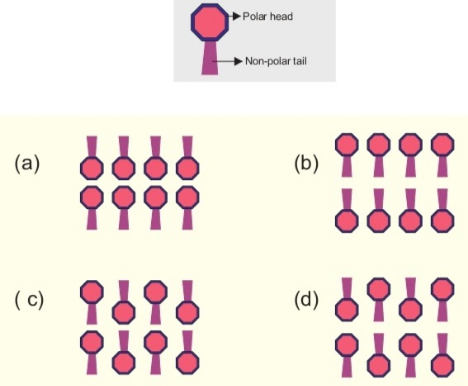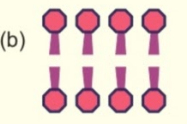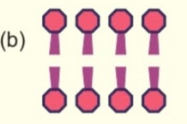
The lipid molecules present in plasma membranes have polar heads and nonpolar tails (as shown in the figure).
Which option represents the correct arrangement of lipids in a lipid bilayer?


Answer
522.6k+ views
Hint: The main component of a plasma membrane are lipids which include phospholipids and cholesterol. Lipid is made of glycerol, a phosphate-linked head group with two fatty acid tails.
Complete answer:
The correct arrangement of lipids in lipid bilayer is:

Lipids are amphipathic i.e. they have two ends: hydrophilic (water-loving) and hydrophobic (water-repelling). This amphipathic nature causes them to form bilayers. Lipid bilayer has one of the most important characteristics which is the fluidity which is very crucial for the membrane. Lipids contain fats, phospholipids and steroids. Fats give energy storage, phospholipid play a vital role in the formation of the cell membrane and steroids allow the chemical functioning of the cell and are also responsible for the structural functioning.
The arrangement of the molecules is in a way that the hydrophilic region is extracellular in the form of a polar head whereas the hydrophobic region is intracellular in the form of a nonpolar tail. The hydrophobic part contains two tails of fatty acids which are present at the centre of the membrane. The fatty acids in the membrane are unsaturated as it makes it easy for the membrane to allow certain molecules. The lipid bilayer is penetrated by the intrinsic proteins which bind them tightly. These are made up of phospholipids and cholesterol.
So, the correct answer is option (b).

Note:
Lipids give the whole world energy as they are buried deep under the ground in the form of oil which produces energy. Lipid is a fat molecule which constitutes almost 50 per cent of the human cell. Lipids are the most important component to build the cell membrane. Lipids show a major role in various illnesses like Alzheimer's disease, cancer, asthma, rheumatoid, arthritis and several inflammatory diseases.
Complete answer:
The correct arrangement of lipids in lipid bilayer is:

Lipids are amphipathic i.e. they have two ends: hydrophilic (water-loving) and hydrophobic (water-repelling). This amphipathic nature causes them to form bilayers. Lipid bilayer has one of the most important characteristics which is the fluidity which is very crucial for the membrane. Lipids contain fats, phospholipids and steroids. Fats give energy storage, phospholipid play a vital role in the formation of the cell membrane and steroids allow the chemical functioning of the cell and are also responsible for the structural functioning.
The arrangement of the molecules is in a way that the hydrophilic region is extracellular in the form of a polar head whereas the hydrophobic region is intracellular in the form of a nonpolar tail. The hydrophobic part contains two tails of fatty acids which are present at the centre of the membrane. The fatty acids in the membrane are unsaturated as it makes it easy for the membrane to allow certain molecules. The lipid bilayer is penetrated by the intrinsic proteins which bind them tightly. These are made up of phospholipids and cholesterol.
So, the correct answer is option (b).

Note:
Lipids give the whole world energy as they are buried deep under the ground in the form of oil which produces energy. Lipid is a fat molecule which constitutes almost 50 per cent of the human cell. Lipids are the most important component to build the cell membrane. Lipids show a major role in various illnesses like Alzheimer's disease, cancer, asthma, rheumatoid, arthritis and several inflammatory diseases.
Recently Updated Pages
Master Class 11 Social Science: Engaging Questions & Answers for Success

Master Class 11 Physics: Engaging Questions & Answers for Success

Master Class 11 Maths: Engaging Questions & Answers for Success

Master Class 11 Economics: Engaging Questions & Answers for Success

Master Class 11 Computer Science: Engaging Questions & Answers for Success

Master Class 11 Chemistry: Engaging Questions & Answers for Success

Trending doubts
What is meant by exothermic and endothermic reactions class 11 chemistry CBSE

10 examples of friction in our daily life

Difference Between Prokaryotic Cells and Eukaryotic Cells

1 Quintal is equal to a 110 kg b 10 kg c 100kg d 1000 class 11 physics CBSE

One Metric ton is equal to kg A 10000 B 1000 C 100 class 11 physics CBSE

Draw a diagram of nephron and explain its structur class 11 biology CBSE




